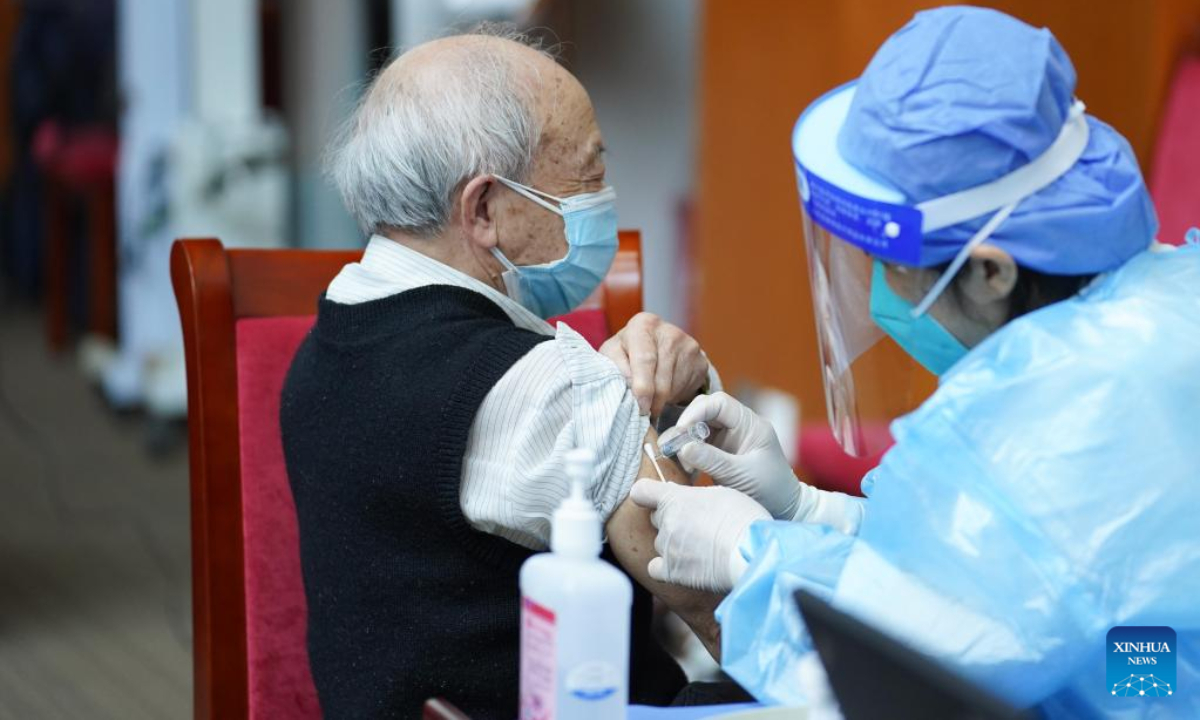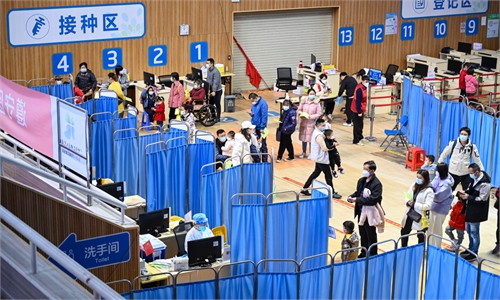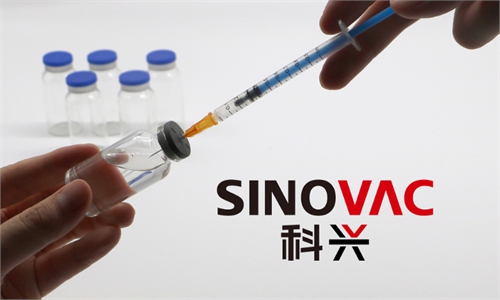Experts suggest building hierarchical diagnosis, treatment for senior COVID-19 patients
Vaccines 'among essential measures to protect vulnerable groups during 1st infection wave

A medical worker injects COVID-19 vaccine for a senior citizen in Dongcheng District of Beijing, capital of China, April 18, 2022. Photo:Xinhua
Medical institutions should build a hierarchical diagnosis and treatment system for senior patients, Chinese experts said, as the protection of the vulnerable groups has shifted to be the focus of the country's COVID-19 prevention and treatment since many epidemic restrictions were dismantled.
"It's necessary to set up a hierarchical diagnosis and treatment system for elderly people, which could diagnose seniors and treat them better based on their health status," Chen Erzhen, a deputy head of Ruijin Hospital in Shanghai, suggested at a training seminar on COVID-19 on Saturday.
The elderly aged 65 and above exceed 200 million people, accounting for 14.2 percent of the Chinese population as of the end of 2021. Data showed elderly people who have underlying diseases and complications such as cardiovascular disease, diabetes and chronic respiratory diseases are susceptible to severe cases.
Chen's remarks answered an essential question that is worrying many - how to protect seniors in the face of the infection surge.
Experts said everything necessary must be done to delay infection of the vulnerable groups and minimize the number of elderly people infected during the first infection wave. Measures such as receiving vaccines as quickly as possible, getting antiviral drugs once they are infected, and separating infected and uninfected seniors are essential steps.
Experts assured that China's optimized COVID-19 response measures don't mean a total relaxation. The new 10 response policies stipulate clearly that the presence of a negative nucleic acid test report and green health code are still required when entering nursing homes and welfare homes. This move can greatly reduce the risk of introducing the virus to these institutions.
In nursing homes, the National Health Commission (NHC) also highlights the adoption of preventive measures to guard against COVID-19 spreading such as ventilating every room, keeping good hygiene, wearing masks properly and reducing gatherings.
The NHC also requires nursing homes to make emergency response plans. Once there is an infection, infected people and non-infected people should be separated to prevent any infection from further spreading.
"We have been under closed-loop management since October. We will carry out a full range of disinfection. The room of the elderly will be illuminated with ultraviolet light, the windows will be opened for ventilation in fine weather," Wang Ronghua, a head of a nursing home in Hohhot, Northwest China's Inner Mongolia Autonomous Region, told Chinese media.
Wang said all elderly people in his nursing home are severely disabled. Every effort has been made to protect the lives of the elderly. "If we find people with high fever or suspected to be positive, we would activate our emergency scheme."
Another nursing home in Hohhot only allows family visits if they present negative nucleic acid tests in a designated area. "We have some medicines ready in reserve. The elderly who have fever and cough will receive medical treatment in our quarantine areas," Meng Jie, the head of this nursing home, told media.
On the medical treatment of elderly people, the country primarily refers to the scheme rolled out by the NHC, which requires building multidisciplinary expert teams to treat the vulnerable groups with one-on-one treatment, Chen said.
Medical treatment for elderly patients should focus on monitoring and treatment of organ function, underlying diseases and prevention of complications, Chen noted. He also suggested an overall evaluation of the health, organ function and psychological health of elderly people, so as to better protect them in the face of the COVID-19 shock.
In an explanation of hierarchical diagnosis and treatment, Chen said senior patients can be categorized into three degrees of risks based on their ages, degree of underlying diseases, whether they are vaccinated, and degree of risks they will experience after COVID-19 infection.
Jin Dongyan, a biomedical professor at the University of Hong Kong, told the Global Times that the primary measure to protect the elderly is to speed up their vaccination, which reduces their risk of getting infected and developing into a severe condition.
"If people aged 80 years or more receive a high enough percentage of vaccines, and antiviral drugs are in sufficient supply, and we place those elderly people who are still uninfected in closed-loop management, I believe China could overcome the epidemic with the minimum number of elderly people infected," Jin said.
As of December 13, more than 240 million people aged 60 and above and more than 2.7 million people aged 80 and above had received COVID-19 vaccines, accounting for 91 percent and 77.5 percent of the total elderly population in China, according to data compiled by the NHC.




